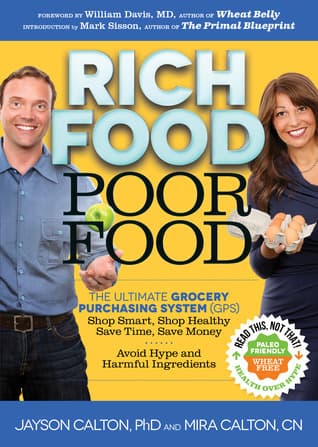
Book Review Summary: Rich Food Poor Food: Your Grocery Purchasing System
Introduction
"Rich Food, Poor Food: Your Grocery Purchasing System" by Jayson Calton is a comprehensive guide that takes readers on a journey through the grocery store, teaching them how to identify and purchase nutrient-dense foods. The book builds on the author's previous work, "Naked Calories," which emphasized the importance of micronutrients in one's diet. In this follow-up, the Caltons delve deeper into the world of grocery shopping, providing practical tips and insights to help readers maximize their health benefits from the food they buy.
About Jayson Calton
Jayson Calton is a renowned nutritionist and author, known for his work alongside his wife, Mira. Together, they have made significant contributions to the field of nutrition, shedding light on the importance of micronutrients and promoting a whole-foods, non-GMO diet. With their extensive knowledge and passion for healthy living, Jayson Calton has become a respected figure in the health and wellness community.
Analysis of Views
-
In-depth exploration of nutrient-dense foods: Readers praise the book for its thorough exploration of nutrient-dense foods, explaining the significance of micronutrients and providing practical tips on how to identify them. The book helps readers understand the importance of choosing whole, unprocessed foods and encourages them to prioritize nutrition over calorie count.
-
Easy-to-follow format: Many readers appreciate the book's logical structure and clear organization. The authors present information in a way that is accessible to everyone, making it easy to navigate and learn from. The book's step-by-step approach to grocery shopping makes it an invaluable resource for both beginners and experienced shoppers.
-
Comprehensive resource: Readers find the book to be a comprehensive resource that covers various aspects of grocery shopping, from understanding food labels to identifying healthy ingredients. The authors provide valuable insights into the food industry, debunking marketing myths and highlighting the importance of reading labels. They also offer practical tips on how to make healthier choices when shopping.
-
Practical advice and recipes: The book offers a range of practical advice, including recipes for making homemade versions of popular foods like almond milk, mayonnaise, and ketchup. Readers appreciate the inclusion of these recipes, which provide an additional layer of knowledge and empower them to make healthier choices in their kitchens.
-
Inspiring and motivating: Many readers find the book inspiring and motivating. The authors' passion for healthy living and their commitment to educating others shine through in their writing. The book not only provides valuable information but also encourages readers to take control of their health by making informed decisions about the food they eat.
Reasons for Recommendation
-
In-depth exploration of nutrient-dense foods: The book's focus on nutrient-dense foods sets it apart from other grocery shopping guides. Readers appreciate the depth of knowledge provided by the authors, which helps them make informed choices about the food they buy.
-
Easy-to-follow format: The book's logical structure and clear organization make it accessible to everyone, regardless of their level of knowledge about nutrition. Readers find it easy to navigate and learn from, making it an excellent resource for anyone looking to improve their grocery shopping habits.
-
Comprehensive resource: The book covers a wide range of topics related to grocery shopping, including understanding food labels, identifying healthy ingredients, and making healthier choices when shopping. Readers appreciate the comprehensive nature of the book and find it to be a valuable resource for anyone looking to optimize their grocery purchases.
Reasons for Not Recommendation
-
Limited scope: Some readers find that the book's focus on nutrient-dense foods may limit its applicability to those following other dietary approaches or with specific dietary restrictions. While the book provides valuable information on healthy eating, it may not be suitable for everyone.
-
Dogmatic approach: A few readers feel that the book takes a dogmatic approach to certain aspects of nutrition, such as its stance on wheat and grains. While this may resonate with some readers, others may find it limiting or not in line with their personal beliefs or dietary preferences.
Conclusion
"Rich Food, Poor Food: Your Grocery Purchasing System" by Jayson Calton is a highly recommended resource for anyone looking to optimize their grocery shopping habits and prioritize nutrition in their diet. With its in-depth exploration of nutrient-dense foods, easy-to-follow format, comprehensive resource, and practical advice, this book provides valuable insights into the world of grocery shopping. While some readers may find certain aspects limiting or dogmatic, overall, "Rich Food, Poor Food" offers a valuable guide for those seeking to make informed decisions about the food they eat and improve their health outcomes.